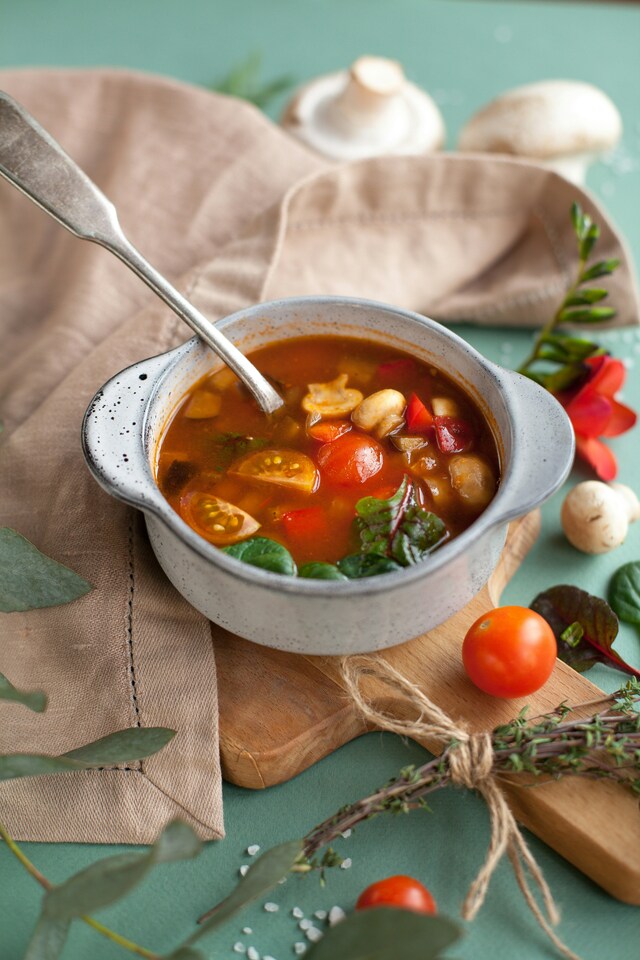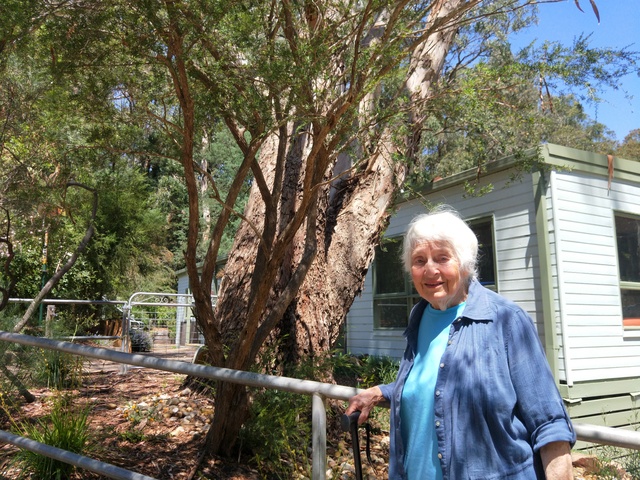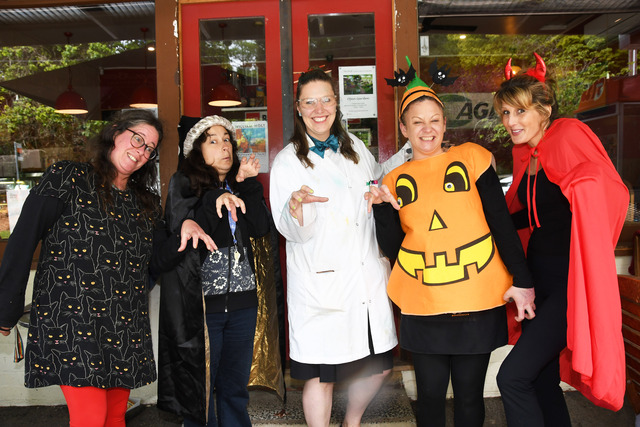When it’s cold, or you’re feeling miserable, what food do you turn to for comfort?
For many of us, the answer is soup.
When prepared with the right ingredients, soup can be a truly healthy dish with multiple nutritional benefits as well as having a positive impact on your emotional and psychological wellbeing.
It also can be the frugal cook’s best friend, turning whatever ingredients are available into something warm and nourishing through a sort of culinary alchemy.
And it’s this supposed alchemy that is at the centre of the old folk tale, variously called the Stone Soup, Hammer Soup or by some other inedible object.
The story goes that once upon a time in small village there was a famine and the people hoarded their meagre food supplies, even from friends and neighbours.
One day, a stranger came to the village carrying nothing but an empty cooking pot.
He then proceeded to build a fire and fill the pot with water, pick up a large stone and drop it into the pot.
The sceptical villagers gathered around wondering how it was possible to make soup out of a stone.
The stranger reassured them that indeed it was very possible but would be even better with a bit of seasoning.
Gradually, the villagers added potatoes, onions, cabbage and whatever else they had squirrelled away.
Before long there was a nutritious, satisfying soup to feed everyone.
The moral of course is that sharing and cooperation benefits everyone.
Soup is the most democratic food.
Enjoyed from prince to pauper as poet Carl Sandburg shows where it seems that a famous man his name” spelled out in tall black headlines,’ suggesting some malfeasance, is seen eating soup, perhaps in a soup kitchen.
I saw a famous man eating soup.
I say he was lifting a fat broth
Into his mouth with a spoon.
His name was in the newspapers that day
Spelled out in tall black headlines
And thousands of people were talking about him.
When I saw him,
He sat bending his head over a plate
Putting soup in his mouth with a spoon.
We live in a wasteful society where there is a tendency to throw out food deemed past its supposed use by date.
Left and forgotten in the fridge it finds its way into landfill.
My version of the Stone Soup is Cleaning out the Fridge Soup where such left overs, as wilting vegetables, remaining bits of deli meats, the rind of parmesan cheese can all by means of
culinary alchemy be turned into a satisfying meal.
Soup holds cultural significance across the world, often associated with comfort, healing, and communal eating.
In many cultures, soup is a staple of traditional cuisine, representing regional ingredients and culinary practices.
Many soups are associated with their country of origin, even though they undergo changes when transplanted.
One such soup is Mulligatawny which had its origins in the India of the British Raj.
It is the Anglicized versions of the Tamil ‘pepper broth’: full of aromatics and spices: curry, cumin turmeric, cinnamon, cloves and nutmeg Brought back home to England the soup quickly became popular because of its versatility.
You could either ‘introduce expensive meats or simply in the spirit of the Stone Soup story add any leftovers that needed to be used up.
It has been said there are as many variations of Borsch as there are Eastern European grandmas: Russia, Belarus, Poland and Ukraine all have versions of this beetroot and cabbage
based soup with Ukraine challenging Russia its origins.
Yet another grievance as culture and geography make the untangling of Russian and Ukrainian history an almost impossible task.
Think of France and what comes to mind invariably is Onion Soup.
Soupe a l’Oignon made with caramelized onions and a hearty beef broth, topped with a slice of bread and melted cheese, a must at dinner parties in the 70s and 80s.
But whenever one thinks of Jewish cuisine invariably it is chicken soup.
Often called by the colloquial term Jewish penicillin because of its reputation as a remedy for colds, flu, and other common ailments.
Not just a culinary staple but a symbol of care, comfort, and tradition, celebrated for its supposed healing properties and cherished across generations.
But if we look at Israeli food culture it reflects the diverse cultural and ethnic backgrounds of the country’s population, though there are both Middle Eastern (Arab) and European culinary
traditions it is Middle Eastern flavours and ingredients that predominate.
Here in Australia, we enjoy the many foods of our multicultural population and soup is no exception.
But then again, as Spaghetti Bolognese is often nominated as our national dish perhaps the Italian Minestrone is the soup we prize most.
Peter Gizzi celebrates the process of making Minestrone in his poem Minestrone Mandate.
cold hard rain slanting in
gives the order: make minestrone
soup. slowly sizzle in olive oil chopped
garlic, yellow onion, celery, carrots, one
potato, green beans, diced tomatoes with juice
(canned okay), a bit of chopped savoy
cabbage, white Italian beans (canned
okay), all in a broth, beef or otherwise–
toss in the heel-hide of a parmesan
wedge–that’s right, don’t be afraid, plus
salt, pepper, oregano to your
liking, and let that cast-iron cauldron
simmer subtly all the day through,
And then when his loved ones come home tired and cold and he serves the soup he sees the healing powers of his labour as they ‘shed coat and stress’.
In the middle of a cold winter there is surely little that is more satisfying than a fragrant bowl of Pho, pronounced Fuh, not faux.
This Vietnamese broth is usually simmered for hours with spices like star anise, cinnamon, and cloves.
On a cold day it is such a restorative soup: a rich flavourful broth, with noodles beef or other protein and lots of fresh toppings of mint, coriander, green onions.
Similarly Ramen originating in southern China from noodle dishes found in regions like Guangzhou it has become a favourite soup.
And if you like a bit of heat as a winter warmer there are hot, sour and spicy soups from Thailand and Korea to choose from.
More recently we have been introduced to Bamya or Okra Soup from Sudan, made with okra, tomatoes, garlic, onions and meat(usually lamb or goat).
Soup can evoke memories of family meals Often we yearn for the soup we ate as children made by a nana, baba, teta or oma or even a grandpa as remembered by Jackie Kay ‘No one
makes soup like my grandpa she begins:
He knows I will grow up and pine for it.
I will fall ill and desperately need it.
I will long for it my whole life after he is gone.
Every soup will become sad and wrong after he is gone.
He knows when I’m older I will avoid soup altogether.
Similarly Australian poet Laura Leav writes:
More than a dish, it’s soul’s elation,
Connecting generations, across the nation,
Beyond the recipe, its essence seeps,
In the heart, it silently creeps.
Soup appearing in poems suggests comfort warmth and the simplicity of everyday life.
William Carlos Williams’ s simple, direct language in The Red Wheelbarrow captures the importance of ordinary objects and small moments of life, much like how soup is often a simple yet
significant part of daily meals: so much depends/upon/a red wheel/barrow/glazed with rain/water/beside the white/chickens.
Not just nourishment and an economical way to provide vitamins, minerals and many other nutrients, soups carry both emotional and cultural meaning.
I hope that somebody entering the Woorilla Poetry Prize may like to take up the challenge of writing a great Australian soup poem.
The Woorilla International Poetry Prize 2024 is now receiving entries.
Please visit woorilla.org.au
Potato Soup by Daniel Nyikos
I set up my computer and webcam in the kitchen
so I can ask my mother’s and aunt’s advice
as I cook soup for the first time alone.
My mother is in Utah. My aunt is in Hungary.
I show the onions to my mother with the webcam.
“Cut them smaller,” she advises.
“You only need a taste.”
I chop potatoes as the onions fry in my pan.
When I say I have no paprika to add to the broth,
they argue whether it can be called potato soup.
My mother says it will be white potato soup,
my aunt says potato soup must be red.
When I add sliced peppers, I ask many times
if I should put the water in now,
but they both say to wait until I add the potatoes.
I add Polish sausage because I can’t find Hungarian,
and I cook it so long the potatoes fall apart.
“You’ve made stew,” my mother says
when I hold up the whole pot to the camera.
They laugh and say I must get married soon.
I turn off the computer and eat alone.







